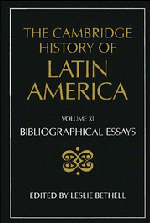Book contents
- Frontmatter
- I THE INDIGENOUS PEOPLES OF MIDDLE AND SOUTH AMERICA ON THE EVE OF THE CONQUEST
- 1 Mesoamerica before 1519
- 2 The Caribbean and circum-Caribbean at the end of the fifteenth century
- 3 The Andes before 1532
- 4 Southern South America in the middle of the sixteenth century
- 5 Brazil in 1500
- II COLONIAL SPANISH AMERICA
- III COLONIAL BRAZIL
- IV THE INDEPENDENCE OF LATIN AMERICA
- V LATIN AMERICA: ECONOMY, SOCIETY, POLITICS, c. 1820 TO c. 1870
- VI LATIN AMERICA: ECONOMY, SOCIETY, POLITICS, c. 1870 to 1930
- VII LATIN AMERICA: ECONOMY, SOCIETY, POLITICS, 1930 to c. 1990
- VIII IDEAS IN LATIN AMERICA SINCE INDEPENDENCE
- IX LATIN AMERICAN CULTURE SINCE INDEPENDENCE
- X THE INTERNATIONAL RELATIONS OF LATIN AMERICA SINCE INDEPENDENCE
- THE CAMBRIDGE HISTORY OF LATIN AMERICA
4 - Southern South America in the middle of the sixteenth century
from I - THE INDIGENOUS PEOPLES OF MIDDLE AND SOUTH AMERICA ON THE EVE OF THE CONQUEST
Published online by Cambridge University Press: 28 March 2008
- Frontmatter
- I THE INDIGENOUS PEOPLES OF MIDDLE AND SOUTH AMERICA ON THE EVE OF THE CONQUEST
- 1 Mesoamerica before 1519
- 2 The Caribbean and circum-Caribbean at the end of the fifteenth century
- 3 The Andes before 1532
- 4 Southern South America in the middle of the sixteenth century
- 5 Brazil in 1500
- II COLONIAL SPANISH AMERICA
- III COLONIAL BRAZIL
- IV THE INDEPENDENCE OF LATIN AMERICA
- V LATIN AMERICA: ECONOMY, SOCIETY, POLITICS, c. 1820 TO c. 1870
- VI LATIN AMERICA: ECONOMY, SOCIETY, POLITICS, c. 1870 to 1930
- VII LATIN AMERICA: ECONOMY, SOCIETY, POLITICS, 1930 to c. 1990
- VIII IDEAS IN LATIN AMERICA SINCE INDEPENDENCE
- IX LATIN AMERICAN CULTURE SINCE INDEPENDENCE
- X THE INTERNATIONAL RELATIONS OF LATIN AMERICA SINCE INDEPENDENCE
- THE CAMBRIDGE HISTORY OF LATIN AMERICA
Summary
The quantity and the quality of early material on the southern cone of South America varies from area to area according to the period. First observers rarely confined their writings to a single ethnic group, but chroniclers, military poets and priests were attracted at once by Mapuche resistance to the conquest. However, similarly worthwhile accounts about other places on either side of the Andes are scarce, and our knowledge of some sixteenth- and seventeenth-century documents is based entirely on references to them in eighteenth-century chronicles.
There is useful information on the northern section of the southern Andes in the region’s earliest chronicle, Crónica y relación copiosa y verdadera de los reinos de Chile, completed in 1558 by Gerónimo de Bibar. Bibar not only accompanied Pedro de Valdivia on his conquest of Chile but also ventured from the northern deserts to the southern archipelago, besides further travels east of the Andes. His account, which has chapters on the geography and ethnography of the provinces he visited, has been widely used by ethnohistorians since its rediscovery and publication in Santiago in 1966. Other interesting works on the northern section include the Relación del descubrimiento y conquista de los reinos del Perú (1571) by Pedro Pizarro, an encomendero of Tarapacá; and the collection of chronicles which document Diego de Almagro’s 1535 expedition to Chile, including Fernández de Oviedo’s Historia general y natural de las Indias, an anonymous Relación attributed to the ‘Almagrist’ Cristóbal de Molina, and Mariño de Lovera’s Crónica del Reino de Chile (1595).
- Type
- Chapter
- Information
- The Cambridge History of Latin America , pp. 19 - 24Publisher: Cambridge University PressPrint publication year: 1995
- 1
- Cited by

